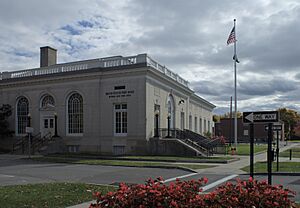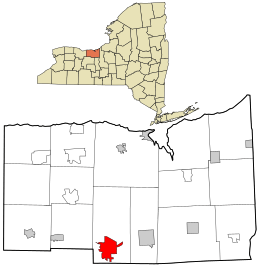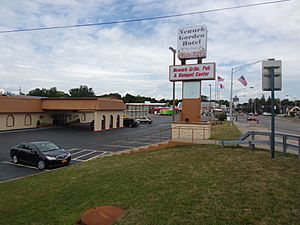Newark, New York facts for kids
Quick facts for kids
Newark, New York
|
||
|---|---|---|

U.S. Post Office in downtown Newark
|
||
|
||

Location in Wayne County and the state of New York.
|
||
| Country | United States | |
| State | New York | |
| County | Wayne | |
| Town | Arcadia | |
| Settled | 1819 | |
| Incorporated | July 21, 1853 | |
| Government | ||
| • Type | Board of Trustees | |
| Area | ||
| • Total | 5.42 sq mi (14.05 km2) | |
| • Land | 5.42 sq mi (14.04 km2) | |
| • Water | 0.01 sq mi (0.01 km2) | |
| Elevation | 457 ft (135 m) | |
| Population
(2020)
|
||
| • Total | 9,017 | |
| • Density | 1,663.96/sq mi (642.46/km2) | |
| Time zone | UTC−5 (EST) | |
| • Summer (DST) | UTC−4 (EDT) | |
| ZIP Code(s) |
14513
|
|
| Area code(s) | 315 and 680 | |
| FIPS code | 36-49891 | |
| GNIS feature ID | 0958486 | |
| Website | Official website: http://www.villageofnewark.com | |
Newark (/ˈnjuːərk/ NEW-ərk) is a village located in Wayne County, New York, United States. It is about 35 miles (56 km) southeast of Rochester and 48 miles (77 km) west of Syracuse. In 2020, the village had a population of 9,017 people.
Newark is found in the southern part of the Town of Arcadia. It is also in the southern area of Wayne County. It is the largest community by population in Wayne County.
Contents
History of Newark, New York
The area that is now Newark used to include two smaller places called "Miller's Basin" and "Lockville." The Village of Newark officially became a village in 1853.
Jackson & Perkins Company History
A famous company known for its roses, Jackson & Perkins Company, started in Newark, New York. It was founded in 1872 by Albert Jackson and his son-in-law, Charles H. Perkins. The old Perkins family home is now a historic landmark.
The Jackson–Perkins House at 310 High Street is important because it shows the growth of the Jackson and Perkins Company. This company became one of the biggest and most famous plant businesses in the United States. Albert E. Jackson and Charles H. Perkins, who were fruit growers and loved gardening, bought the property in 1864.
At first, Charles Perkins, who was a lawyer and banker, started growing grapes and other fruits. But he became very interested in roses. In 1884, the company hired E. Alvin Miller, an expert in growing and breeding plants. This helped the company grow a lot. They began to grow roses and other decorative plants on a large scale. Even though the company bought more farms, the High Street estate remained the main center. Plant experiments happened there, and the house's library was the company's main office. In 1910, Charles Perkins's son, George C. Perkins, became the president.
In the early 1900s, Jackson and Perkins became famous worldwide, especially for its roses. In 1908, they won an award for their popular "Dorothy Perkins" climbing rose. During the 1920s and 1930s, the company's researchers created hundreds of new plant types. The company sold millions of plants. Besides roses, Jackson and Perkins also sold many clematis, lilacs, boxwoods, azaleas, and rhododendrons.
For over 50 years, the company mainly sold plants to other businesses. But after a popular display at the 1939 New York World's Fair, they started selling directly to people through mail order. During World War II, the biggest rose grower in Germany closed down. This allowed Jackson and Perkins to become known as the "Rose Capital of America" and the world's rose garden. Today, Jackson and Perkins is located in Hodges, South Carolina. It is part of the Park Seed Co. and sends out millions of catalogs and plants each year.
Other Local Businesses
In 1852, Charles W. Stuart bought a farm on what is now North Main Street. He started selling fruit trees door-to-door. This was the start of the C.W. Stuart Nursery, which became one of the largest plant nurseries in the country.
In 1949, C.H. Stuart Co. (Charles W. Stuart's son's company) created a new division called Sarah Coventry Inc. It was named after C.H. Stuart's great-granddaughter, Sarah Coventry Beale. This company sold costume jewelry until 1984.
Newark has grown to become an important center for industry and shopping in Wayne County. The Jackson–Perkins House and the United States Post Office are both listed on the National Register of Historic Places.
Erie Canal and Local Landmarks
Newark is part of the Erie Canalway National Heritage Corridor. You can still see parts of the old Enlarged Erie Canal Lock 59 (also called the Upper Lockville Lock) along North Clinton Street. This lock was built in 1841. It helped boats go up or down about 7.88 feet (2.40 m). Another old lock, Lock 58 (Middle Lockville Lock), is a few blocks east. Volunteers have cleared one part of it for a canal trail project.
There's also a lesser-known part of the original Erie Canal on West Union Street. It's where Military Brook, also called Whipspool Creek, used to flow under the canal. It then continued through the Newark Cemetery on its way to the Ganargua Creek.
The Erie Canal Lock 28B is located under the bridge on North Clinton Street. It was built around 1913 and helps boats go up or down about 12 feet (3.7 m).
Hoffman Clock Museum
In December 1954, the Hoffman Clock Museum opened inside the Newark Public Library. The museum's collection is named after Augustus Hoffman. He was a Newark resident and a watchmaker who gathered many of the clocks and watches now in the museum.
Village of Arcadia's Merger into Newark
There was once a community called Lockville, first settled around 1805. It was about 3⁄4 mile (1.2 km) east of Miller's Basin. Lockville got its name because it was near three locks (57, 58, and 59) on the original Erie Canal. In 1839, Lockville became its own village called the Village of Arcadia. Later, in 1853, it joined with Newark when Newark became an incorporated village.
Geography of Newark
Newark is located at 43°02′48″N 77°05′43″W / 43.04667°N 77.09528°W. It sits along the southern edge of Wayne County, right next to Ontario County. The village covers a total area of about 5.4 square miles (14 km2). Most of this area is land, with only a tiny bit of water.
The main part of the village is where Main Street (New York State Route 88) and Union Street (New York State Route 31) meet. Route 31 runs right next to the southern bank of the Erie Canal.
Population and People
| Historical population | |||
|---|---|---|---|
| Census | Pop. | %± | |
| 1870 | 2,248 | — | |
| 1880 | 2,450 | 9.0% | |
| 1890 | 3,698 | 50.9% | |
| 1900 | 4,578 | 23.8% | |
| 1910 | 6,227 | 36.0% | |
| 1920 | 6,964 | 11.8% | |
| 1930 | 7,649 | 9.8% | |
| 1940 | 9,646 | 26.1% | |
| 1950 | 10,295 | 6.7% | |
| 1960 | 12,868 | 25.0% | |
| 1970 | 11,644 | −9.5% | |
| 1980 | 10,017 | −14.0% | |
| 1990 | 9,849 | −1.7% | |
| 2000 | 9,682 | −1.7% | |
| 2010 | 9,145 | −5.5% | |
| 2020 | 9,017 | −1.4% | |
| U.S. Decennial Census | |||
In 2010, there were 9,145 people living in Newark. There were 3,842 households and 2,256 families. The village had about 1,691.6 people per square mile (653.1 people/km2) living in each square mile.
Most of the people in the village were White (89.0%). About 5.0% were Black or African American. Around 7.4% of the population identified as Hispanic or Latino.
The average household size was 2.39 people, and the average family size was 2.94 people. About 25.4% of the population was under 18 years old. The median age in the village was 38 years.
Housing in Newark
In 2010, there were 4,098 housing units in Newark. About 54.2% of these homes were owned by the people living in them. The other 45.8% were rented.
Notable People from Newark
Many interesting people have connections to Newark, New York:
- Esbon Blackmar (1805–1857) was a politician who served in the U.S. House of Representatives.
- Tom Burgess is a Canadian football All-Star Quarterback.
- Admiral Leslie E. Gehres was the Captain of the USS Franklin (CV-13) during World War II.
- Peter Hannan is a television producer and writer. He created the animated series CatDog.
- Charles R. Jackson (1903–1968) was the author of the famous novel The Lost Weekend.
- Doug Kent is a professional ten-pin bowler and a Hall of Famer.
- Lowell "Bud" Paxson (died 2015) founded Paxson Communications, Pax TV, and the Home Shopping Network. He started his career with a local radio station in Newark.
- Sybil Shearer (1912–2005) was a pioneer in modern dance. She grew up in Newark, New York.
See also
 In Spanish: Newark (Nueva York) para niños
In Spanish: Newark (Nueva York) para niños





